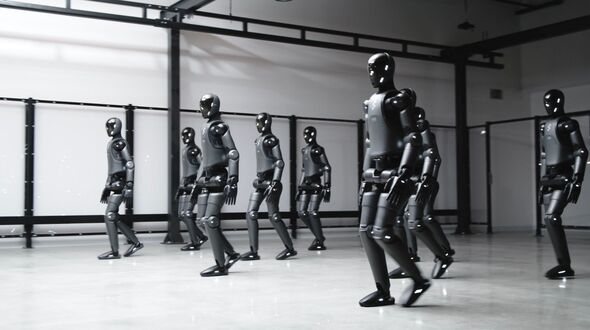Eerie video shows robot 'army' marching after AI teaches them to walk like humans
Using artificial intelligence, Figure has successfully improved the walking abilities of its robots to mimic human movements. The development signifies a significant advancement in the field of robotics, particularly in creating more human-like humanoid robots. By leveraging AI technology, Figure aims to enhance the functionality and capabilities of its robotic creations. The company's innovative approach demonstrates the potential for AI to revolutionize the robotics industry and bring about more sophisticated robotic systems. This breakthrough showcases the continual progress in robotics technology and its potential to reshape various industries.

Artificial intelligence has been teaching robots how to walk like humans and the results are incredibly eerie. Humanoid robots are constantly advancing and for years they've been able to beat us at chess and perform impressive actions including cartwheels, backflips and even dancing. Despite this, they still struggle with tasks that appear simple to humans, including walking in a straight line, gripping onto objects or tying shoelaces. The problem, known as Moravec's Paradox, occurs because while robots excel at tasks that require complex calculations and large datasets, they lack the real-world experiences humans have had during millions of years of evolution. As a result, the shuffling gait humanoid robots often possess easily sets them apart from humans.
Figure's Advancements in Humanoid Robot Walking
US robotics company Figure has taken major steps to combat this with the help of AI. The tech company showcased its Figure 02 robot marching with a "human-like" gait in a new promotional video. "These initial results are exciting, but we believe they only hint at the full potential of our technology," company representatives wrote in a post accompanying its announcement. "We're committed to extending our learned policy to handle every human-like scenario the robot might face in the real world."
Figure's engineers used a technique called reinforcement learning to train the robots to walk more like real humans. The AI method uses a trial-and-error simulation that optimizes behaviors based on a reward signal. The company trained its reinforcement learning controller by placing thousands of virtual humanoids inside a physics simulator that recreated various terrains. The virtual robot arms were rewarded for natural motions, which led to them refining their gaits to appear more human-like.
Figure then uploaded the "Learned Natural Walking" model it had created through the simulation to a real-world Figure 02 robot, leading to it walking somewhat naturally, with heel strikes, toe-offs, and synchronized arm swings. The company shared a clip of 10 Figure 02 robots operating using the same reinforcement learning network without any tweaks or changes. "This gives us hope this process can scale to thousands of Figure robots in the near future," Figure said.
Future Plans of Figure
The California company has plans to roll out its humanoid robots on factory floors. They have already been tested in a BMW factory last year and there are plans to introduce more of the robots this year.

